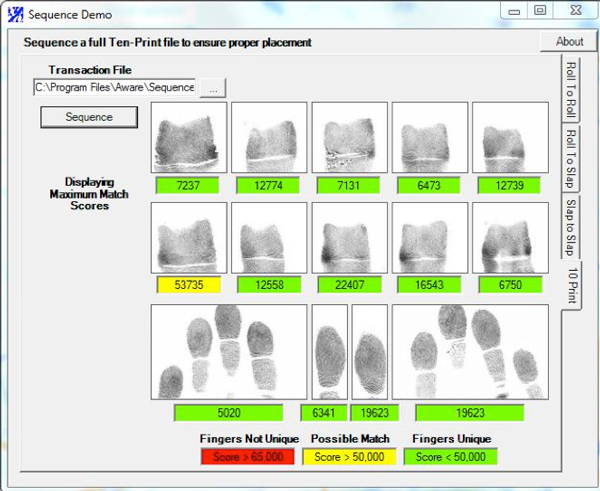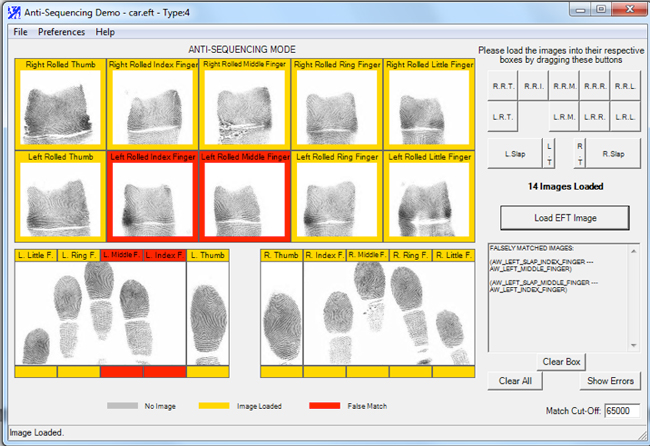SequenceCheck™
Fingerprint segmentation, sequence checking, and quality scoring for advanced quality and compliance assurance
SequenceCheck provides matching and image quality measurement for multi-finger live scan and card scan systems. It is an API designed for applications requiring a high level of fingerprint image quality assurance. The collection of fingerprint image data for government, civil applicant, immigration, or criminal databases typically includes the collection of two sets of four-finger “slap” images, ten rolled finger images, and an “impression” of each thumb. Errors can occur during the acquisition of fingerprint image data during the live scan or inking process. For example, the impressions can be placed in the roll locations, or the roll images can be arbitrarily placed into the wrong boxes on the paper or electronic record. The images can be smudged or of low contrast. SequenceCheck is broadly used, highly accurate, and error-resilient.

SequenceCheck reports match scores between slaps and rolls of each finger.

SequenceCheck reports non-matching slaps and rolls of the same finger.
SequenceCheck helps to maintain the integrity of the image data, and improve biometric matching performance by confirming that each finger meets a minimum image quality threshold, and that it is properly identified.
Features
API Functionality
Use with Other Aware Software Products
SequenceCheck can be used seamlessly with several other software products from Aware. It can be used with AccuScan to perform quality assurance on images scanned from fingerprint cards. NISTPack can be added to perform FBI-certified WSQ compression and ANSI/NIST-ITL 2013 (and earlier) compliant data formatting.
SequenceCheck applies several advanced algorithms to perform the following tasks:
Slap Segmentation
This is the process of partitioning each multi-finger image into multiple single finger images. These images can consist of a four-finger “slap” or any combination of one to four fingers.
Single Finger Segmentation
This is the process of extracting only the single contiguous fingerprint image data from a larger image. This process removes noise and dirt from the periphery of the image and centers the finger print image data in a new, clean image.
Fingerprint Image Quality Scoring
This step involves the generation of statistics and measurements on the fingerprint image data using QualityCheck. The raw data can be returned so a quality score can be tuned to meet the characteristics of the scanning device, or a single image quality score can be returned based on a combination of the measurement data. Image quality scores reflect contrast, brightness, image size, ridge flow, and minutiae counts.
Fingerprint Encoding
This is the process by which the minutiae data and the core/delta regions of each image are determined. This data is used in the matching process and is output to an application through an API call.
Fingerprint Identification
This is the final step in the sequence; it uses the data generated by the other steps and applies a matching algorithm to the minutiae points. A match score is generated. Match/no-match can be determined by setting a threshold value. Typically, matches generate scores that are significantly higher than non-matches. In most cases, non-matches generate a score of zero.
The major function areas described above are provided through an easy-to-understand and easy-to-implement API. SequenceCheck includes example programs with source code that demonstrate how best to integrate it into a larger application. The design of SequenceCheck assumes no predefined workflow; individual functions can be called in almost any order to perform any sub-component of the sequence checking.
Palm Image Quality Check
SequenceCheck provides support for palm image quality. Functionality includes leftness and rightness measurement, full hand segmentation (separation of four fingers from the full hand), comparison of upper palm with lower palm to ensure each originated from the same hand, and global quality scoring on the palm image data.